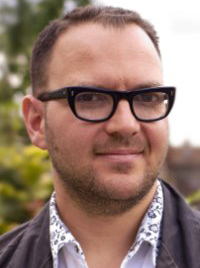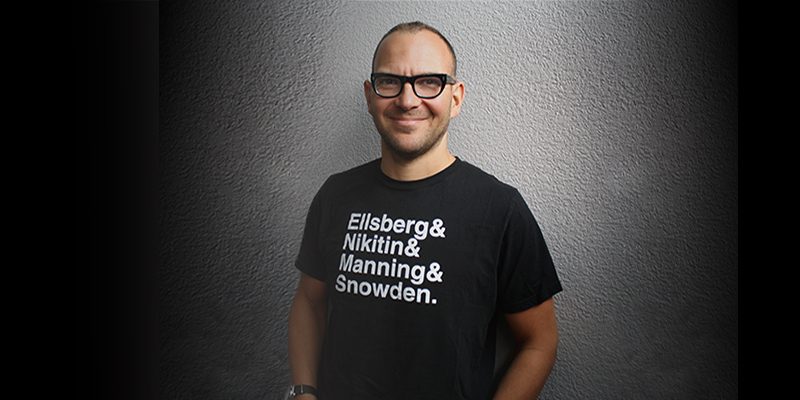Cory Doctorow: Fake News Is an Oracle

Several times over the 13 years that I’ve been writing this column, I’ve railed against the toxic myth that science fiction is a predictive literature, a way to know the future. Science fiction writers are not fortune tellers, and that’s obvious because no one is a (real) fortune teller, because the future is unknowable, and because the future changes based on what we do.
With that said, there are two different ways in which science fiction has a relationship to our future: first, it can serve as a warning or an inspiration, influencing the actions that people take and thus the future that they choose.
Second, and far more interestingly, science fiction can act as a kind of Ouija board for our societal ideomotor response. When you and your friends put your hands on the Ouija’s planchette and invite the spirits into the room, the movement of the planchette is driven by tiny, subconscious nerve impulses that cause you and your friends to move it around the board, picking out messages. Those messages aren’t from the Great Beyond, but they are from a mysterious realm, the usually invisible and inchoate world of your and your friends’ unspoken desires and fears.
In the same way, science fiction responds to our societal ideomotor responses. First, the authors write the stories about the futures they fear and relish. These futures are not drawn from a wide-open field; rather, they make use of the writer’s (and audience’s) existing vocabulary of futuristic ideas: robots, internets and AIs, spaceships and surveillance devices. Writers can only get away with so much exposition in their fiction (though I’ve been known to push the limits) and so the imaginative leaps of a work of fiction are constrained by the base knowledge the writer feels safe in assuming their readers share.
So the writers write the stories. Then the editors choose some of those stories to publish (or the writers publish them themselves). Then readers choose some of those stories to elevate to the discourse, making them popular and integrating them into our vocabulary about possible futures, good and bad. The process of elevation is complicated and has a lot of randomness in it (lucky breaks, skilled agents, PR wins, a prominent reviewer’s favor), but the single incontrovertible fact about a SF work’s popularity is that it has captured the public’s imagination. The warning in the tale is a warning that resonates with our current anxieties; the tale’s inspiration thrums with our own aspirations for the future.
Reading a writer’s fiction tells you a lot about that writer’s fears and aspirations. Looking at the awards ballots and bestseller lists tells you even more about our societal fears and aspirations for the future. The system of writers and readers and editors and critics and booksellers and reviewers act as a kind of oracle, a societal planchette that our hands rest lightly upon, whose movements reveal secrets we didn’t even know we were keeping.
Which brings me to “fake news.”
“Fake news” is a nearly useless term, encompassing hoaxes, conspiracy theories, unfalsifiable statements, true facts spoken by people who are seeking to deceive audiences about the identity of the speaker, and as a catch-all meaning, “I read a thing on the internet that I disagree with.”
But for all that, “fake news” is useful in one regard: the spread of a given hoax, or unfalsifiable statement, or truth delivered under color of falsehood, or conspiracy, or objectionable idea undeniably tells you that the idea has caught the public imagination. The fake news that doesn’t catch on may have simply been mishandled, but the fake news that does catch on has some plausibility that tells you an awful lot about the world we live in and how our fellow humans perceive that world.
Take the anti-vax movement. It proceeds from two observations about the world: first, that the pharma industry (like so many other industries) has become concentrated to the point where executives no longer fear meaningful competition. Second, its execs are part of a cozy club that is small enough that its key members can fit around a single boardroom table and undertake conspiracy with one another.
Second, anti-vaxers believe that the regulators who are supposed to be keeping industry honest are instead willfully blind to the misdeeds of the giants that make up the industry. The regulators are largely drawn from the executive ranks of the industry, and/or they expect to find work in those industries when they leave government service. The regulatory process – nominally a truth-seeking exercise driven by evidence – has become an auction, with regulatory outcomes available to the highest bidder. What’s more, the auction has so few serious bidders (thanks to industry concentration) that they’re able to collude to get stellar bargains out of the people’s watchdogs.
So anti-vaxers say, “Pharma is corrupt and will literally murder you to earn an extra dollar. Regulators let them get away with literal murder, and that’s why we find the idea that vaccines are unsafe to be so eminently plausible.” What’s more, evaluating the safety of vaccines is an esoteric, highly technical matter, one that combines the statistical literacy to evaluate studies with the media literacy to understand the difference between reputable journals and disreputable ones, and that’s before you get to the microbiology, chemistry, and epidemiology. The truth is that none of us are qualified to understand the evidentiary basis for almost everything we believe, so we evaluate the process by which the evidence is weighed by people who are qualified.
The anti-vaxers have a point. Not about the safety of vaccines. I believe they are 100% wrong about vaccines and that everyone who can should get a full schedule of vaccines for themselves and their children.
But anti-vaxers have a point about the process.
About 20 years ago, Purdue Pharma introduced a new blockbuster painkiller to replace its existing flagship product, MS Contin, whose patent had expired. The new drug, Oxycontin, was said to be safe and long-lasting, with effects that would last an incredible 12 hours, without provoking the fast adaptation response characteristic of other opioids, which drives users to take higher and higher doses. What’s more, the company claimed that the addictive potential of opioids was vastly overstated, citing a one-paragraph letter to the New England Journal of Medicine penned by Boston University Medical Center’s Dr. Hershel Jick, who claimed that an internal, un-reviewed study showed that opioids could be safely given at higher doses, for longer times, than had been previously thought.
Purdue Pharma weaponized the “Jick Letter,” making it one of the most-cited references in medical research history, the five most consequential sentences in the history of NEJM. Through a cluster of deceptive tactics – only coming to light now through a string of state lawsuits – Purdue created the opioid epidemic, which has killed more than 200,000 Americans and counting, more than died in the Vietnam War. Purdue made $31 billion. The Sackler family, owners of Purdue, are now richer than the Rockefellers.
The regulators had every reason to know something terrible was going on, from the small town pharmacies ordering millions of pills to the dead piling up on the streets of American cities and towns. The only way they could miss the opioid crisis and its roots in junk science was if they were actively seeking not to learn about it – and no surprise, given how many top regulators come from industry, and have worked at an opioid giant (and more: they are often married to pharma execs, they’re godparents to other pharma execs’ kids, they’re executors of pharma execs’ estates – all the normal, tight social bonds from the top players in concentrated industries).
Ten years ago, if you came home from the doctor’s with a prescription for oxy, and advice that they were not to be feared for their addictive potential, and an admonition that pain was “the fourth vital sign,” and its under-treatment was a great societal cruelty, you might have met someone who said that this was all bullshit, that you were being set up to be murdered by a family of ruthless billionaires whose watchdog had switched sides.
You might have called that person an “opioid denier.”
Today, we worry that anti-vaxers represent the resurgence of long-dormant epidemic. Tomorrow, we may find that they presaged an epidemic of collapsed trust in our shared ability to determine the truth.
We view fake news as though it was a contagion: some people have bad ideas, and if you get too close to them the bad ideas will rub off on you and you’ll get them too. Anti-vax thinking has been around literally since the invention of the first vaccines, but it had been as dormant as measles for decades, until something changed.
Some people say that anti-vax came back because we forgot how terrible measles was. Some say it’s Big Tech and its ability to amplify bad messages. But not everyone is anti-vax. It remains a fringe view (albeit one that has the power to do real harm). What is it that makes some people vulnerable to anti-vax messages?
I think it’s the trauma of living in a world where there is ample evidence that our truth-seeking exercises can’t be trusted. That’s a genuinely scary idea, because if the truth is open to the highest bidder, then we are facing a future of chaos and terror, where you can’t trust the food on your plate, the roof over your head, or the school your child attends.
Fake news is an instrument for measuring trauma, and the epistemological incoherence that trauma creates – the justifiable mistrust of the establishment that has nearly murdered our planet and that insists that making the richest among us much, much richer will benefit everyone, eventually.
The contagion model for fighting fake news – replacing untrue statements with true ones – is like firefighting. It’s necessary, but it is responsive, even reactionary.
The trauma model of fake news says that the fires will continue until we clear away the brush that makes them so easy to spark: until we address the underlying corruption that is rotting our society, fires will continue to rage.
Simply put: if you want to make conspiracy theories less plausible, you should start by stamping out conspiracies.
We’re in the midst of a great debate about the causal relationships of massive changes in our society. Did Trump cause Trumpism, or did Trumpism give rise to Trump? I think that it’s the latter. Trump isn’t smart enough to be the cause of much of anything. But our society has a Trump-shaped hole in it, a place for someone who taps into incoherent anger. Trump is the planchette, and the voters were the ideomotor response, the gerrymanderers and disinformation warriors who got him over the top made a difference at the margins, but they wouldn’t have been able to move the planchette if the ideomotor response wasn’t pushing it towards the presidency to begin with.
Cory Doctorow is the author of Walkaway, Little Brother, and Information Doesn’t Want to Be Free (among many others); he is the co-owner of Boing Boing, a special consultant to the Electronic Frontier Foundation, a visiting professor of Computer Science at the Open University and an MIT Media Lab Research Affiliate.
This article and more like it in the July 2019 issue of Locus.
 While you are here, please take a moment to support Locus with a one-time or recurring donation. We rely on reader donations to keep the magazine and site going, and would like to keep the site paywall free, but WE NEED YOUR FINANCIAL SUPPORT to continue quality coverage of the science fiction and fantasy field.
While you are here, please take a moment to support Locus with a one-time or recurring donation. We rely on reader donations to keep the magazine and site going, and would like to keep the site paywall free, but WE NEED YOUR FINANCIAL SUPPORT to continue quality coverage of the science fiction and fantasy field.









This is a frightening and cogent analysis. Thanks to Cory for writing it, and to you for publishing it.
Best —
jon
PS: (I haven’t seen any other comments; apologies if this is a duplication.) Please fix the typo (“incohate”) near the end of the third graf.
Cory – fascinating and deeply disturbing essay. Minor point – I believe your second second is probably an error strictly from a numbering or structural point of view.
But more on point – its not 100% clear what you are referring to as junk science. The Jick letter was largely observational with strong limitations that were noted there. One can argue that its not science at all. It seems to me to be an attempt at a canary in the mine shaft, dieing too early and sending off the wrong signal. I would not call that junk science at all – and its clear Jick is deeply disturbed by how it has been used.
Now if junk science was referring to the disingenuous uses to which other put his letter I totally agree!
Thanks for the nuance, Cory. There’s much more nuance, too, under the surface of dangerous labels like “anti-vaxxer.” Such labels create an aura of pedantic fiction around something complex. They are the smoke and mirror self-righteousness. Some people are freaked over what seems like a plausible conspiracy; but others are just worried about chemicals they don’t understand being injected into a precious little being. Some people are literally nuts, but others feel that parents should have the _right to decide whether to vaccinate or not — even as they might believe that vaccinating is wise. If there are risks in vaccinating, shouldn’t we be able to be frank about them, but still persuade each other that the risks are worth the benefit of preventing large-scale outbreaks? If the vehemence of this discussion of the “common good” were applied evenly, climate change would be solved, and rivers would be clean. We would have a good educational system. We thus project our failures to address the collective needs onto the parents of newborns. Pure rationalism is not going to change how parents relate to their infant children — and shaming and coercion isn’t either — but education, compassion, and honesty work pretty well.
The “risks” that I’ve heard of break into three buckets.
1) Autism. This has been debunked – it is not true – and has gone a long way to permanently damage the reputation of one of the great science journals of the last 50 years.
2) Giving so many at one time is a “problem”. This has been studied. There are *no* measurable downsides to this approach. The downside to spreading them out is that some parents don’t come back and finish the series.
3) Thiomersal in some vaccines causes autism. See #1.
“We” – the scientific community – have been very frank about the risks of vaccinations. From the three complaints you hear of there are *no* known or measurable risks. None.
Parents do in fact still have complete control over whether or not to vaccinate their children in the US. The cost of choosing to not do it can indeed be quite high. But the cost of the next preventable outbreak is quite high as well.
Vaxing essentially comes down to you beeing convinced owing something to society. If you don’t trust that other people will do the same (mainly because you are able to solidarize with each other) and just freeload on your decision, then it is quite irrational to take even the slightest risk in injecting chemicals in your or your kids blood. So parents are already quite rational in their decisions. One can introduce coercion in this situation but only for so long because that is not defeating the initial reasoning why vaxing a thing of the past.
You almost had me … then “the gerrymanderers who got [Trump] over the top.” Put in the “people lying to me” category.
This is all well and good except that the dotard is part of a cycle that started with Nixon. Each successive Republican president has been worst than the previous one. Each one more bold and open about their objectives. Each one going the next step in enabling the rich to do what they want and what they want is to simply enrich themselves even more at everyone’s expense. But there was the problem of what to do with interim periods when Democratic party presidents were elected. All of the “good work” risked being undone by a party that brought the world out of recession by enabling the working class. The solution came in the form of Bill Clinton and his successor, Obama, took it to another level. Clinton brought about a fundamental change to the Democratic party. He sold it to the rich. The rich now had 2 parties and in American politics that’s the same as saying that they had all of the parties. Eliminating the Democrats wasn’t an option but this worked out to their advantage because eliminating Democrats would have left the rich vulnerable to an upstart second party. Co-opting however was the better solution anyway. Today, this seeming power vacuum at the top is in fact part of a cycle initiated by Nixon and enabled by Clinton. Treating it as an anomaly misses the point of what is going on.
This is so thoughtful, and says so much in such a concise piece, Cory.
The trauma isn’t just underlying corruption though, and is likely much older, deeper, and broader than the corruption of modernity. Saying it’s about trust gets closer to the root of it. Personal trauma, societal trauma, and collective karmic trauma (if that’s your jam) are the casual events of the fear that leads to the NEED for the belief of conspiracies and fake news. My concern though is that I have never seen change take place in an individual without first a life-altering event that leads to greater self awareness. I worry that in order for us to have a collective wake-up we may need a collective life-altering event. Maybe this — this era– is it?
To use the term”willfully blind” is willfully ableist and willfully ableist.